Playtest and After Action Report of John Hill’s new ACW Rules – “Across a Deadly Field”
— By Patrick LeBeau
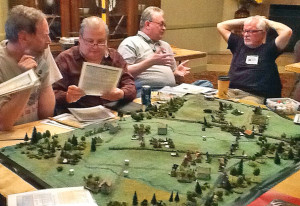
Across A Deadly Field at Fall In 2013 – Generals Kermit, Patrick, George and Dean discuss tactics in ADF. Photo by P.J. O’Neill
As one of most studied and one of the most gamed American Civil War (ACW) battles, Gettysburg offers the miniature gamer a standard from which the value of new set of ACW miniature rules can be measured. In the case of John Hill’s Across a Deadly Field (ADF), the measure is a test of clarity, scale and playability. The described intent of the rules set is the possibility of gaming large battles on a reduced physical space and in less time while maintaining a high standard of playability and player enjoyment.
John’s ADF rules are scheduled for release and publication by Osprey in June of 2014 and the task assigned a group of veteran gamers was to test the scale and playability of the ADF rules within a plausible “what if” ofthe Gettysburg battle environment. Since this was to be a test not just of the rules but also of their clarity of presentation, John was not present to answer our questions. We had only John’s ADF Reference Charts to guide us through the game.
So as we gathered on a warmish November day at the HMGS, Fall In convention in Lancaster, Pennsylvania, we opened our minds to a new gaming experience and immersed ourselves in the imagined possibility “If Slocum wasn’t Slow” on July 1, 1863. The battle was originally published as a Johnny Reb III scenario published in the last issue of Scott Mingus’ Charge magazine and has been adapted by John for his new ADF rules. We were here to increase our understanding of ADF rules set, to test the validity of the scenario design and most of all, to have fun.
East and north of Gettysburg Jubal Early’s division deployed to force their way across the York Pike. BG Gordon’s brigade is ordered to pin elements of the Union XI Corps, situated north of Harrisburg Road but west of the Rock Creek. Having anchored his right flank, Gordon pushed his remaining regiments in a coordinated assault against McDougall’s Brigade, of General Slocum’s XII Corps stretched in defensive line west of the Low Hill. Hays’ Brigade pressed to the Montfort Farm and wheeled to face westward, while BG Harry Hays consolidated Tanner’s, Garber’s, Green’s and eventually Carrington’s artillery batteries on and south of the Low Hill crest line and east of the Montfort Farm. Hoke’s brigade, commanded by Colonel Isaac Avery, marched directly south toward the Hospital Woods and then to attack the High Hilltop field. As they arrived, Smith’s brigade marched down the Harrisburg Road in direct support of Gordon.
Early faced BG William’s 1st Division of Slocum’s XII Corps, supported by the XII’s corps artillery brigade.. The Napoleon batteries moved and deployed on the right of McDougall’s brigade and slightly north of the Schaffer Farm, between the north and south forks of the small streams. The Napoleons would later inflict heavy casualties on Confederate infantry moving and fighting the Low Hill Crest Line area. The 10 pounder rifles moved to the high ground east of Wolf’s road but short of the High Hilltop Field. The deployment of the rifles would later be blocked in a few cases by intervening Union troops of Third and Second brigades. McDougall’s brigade immediately formed extended line. Arriving turn 1 on Wolf’s Road in the middle south edge of the battlefield, Third Brigade marched to the York Pike and headed east towards Hospital Woods. As they arrived over several turns, Second Brigade followed the Third.
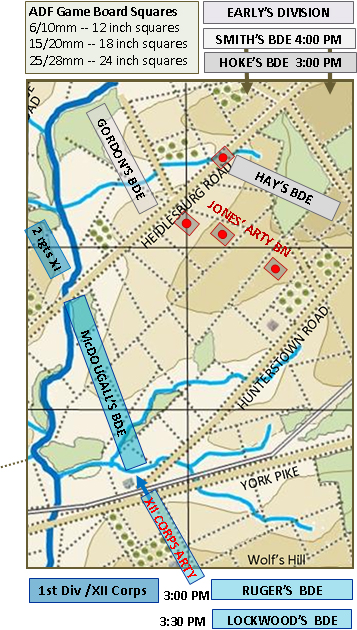
Turns 1 and 2: Long-range artillery fire and skirmishing netted few significant results over the first two turns; but, figures on both sides were removed. Numerous morale checks were made but none failed due to flank support and adjacent leaders. Most units of both sides moved to gain advantage of terrain and to threaten flanks of enemy units. The Union units would enjoy superior field positions due to the defensive nature of their deployment.
Turn 3: Casualties on both sides significantly increase, due to contiguous fire-groups of regiments taking advantage of combined fire and artillery units combining fire from and for the same reasons. The Union artillery shows its dominance in this and subsequent turns, especially the Napoleons. The Confederate artillery increased effectiveness by combined fire but the fire was slow to develop due to the time for them to consolidate.
Turn 4: Casualties mount. Significant loses started to accumulate in McDougall’s brigade. One was close to depleted. Suddenly two of McDougall’s regiments, on his left and in extended line, charged skirmishers, forcing them to disengage but triggering a counter charge by the 13th Georgia. In battle line, the Georgian’s forced the two Union regiments to retreat with heavy casualties but short of destruction. However, the Georgians captured the bridge where the Heidlesburg Road crossed the Rock Creek, which they never relinquished.
Confederate Turn 5: Meanwhile the Union Third Brigade intercepted Hoke’s brigade in the Hospital Woods, north of the York Pike but south of Railroad line. Despite a well-planned charge the lead elements of the Union Third were repulsed with heavy casualties and with one regiment destroyed. At the Harrisburg Road Bridge and south of the bridge,Gordon’s brigade, now supported by Smith, orchestrated another devastating charge on the center elements of McDougall’s brigade. The Union troops are forced to withdraw and the Confederates are declared winners.
Our collective response to the rules and the scenario was overwhelmingly positive. We all had fun, we had very little problems understanding the ADF Reference Charts and we played a divisional sized scenario with 15mm figures representing one-third of the first day of the Gettysburg Battlefield in a 4 ½ feet x 3 feet playing surface and we were able to determine a winner in about 3 to 3 ½ hours. Most of the players were new to the rules, so this game could be played in 3 hours or less, once everyone was familiar with the rules.
As I mentioned, this was originally an JR III scenario that was easily converted to ADF since in JR III each figure equals 30 men and in ADF each figure equals 60 men and in the 15mm version of ADF the ground scale is roughly one inch equals a 80 to 100 yards, which is just about twice the JR III scale. So, any future ADF scenario can be easily converted to JRIII scenario and vice-versa.
Abbreviated Order of Battle
Union: 1st Div/XII Corps – 3 brigades: McDougall’s, Lockwood’s and Ruger’s with 4 batteries.
Confederate: II Corps/Early’s Division – 4 brigades: Gordon’s, Hays’, Hoke’s and Smith’s with 4 batteries.
The Game Players: Patrick LeBeau (Gamemaster), Kermit Hilles, George Miksad, Dean West, Steven Geisinger, Grant Daniels, P.J. O’Neill
Here is a link to another Cigar Box Battle article on ADF and a link to pre-order “Across a Deadly Field”: http://www.cigarboxbattle.com/across-a-deadly-field-acw-rules/
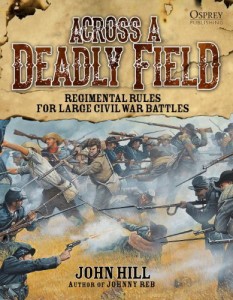

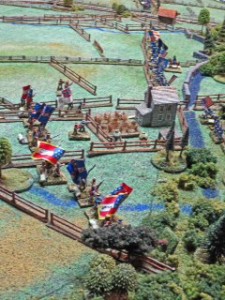
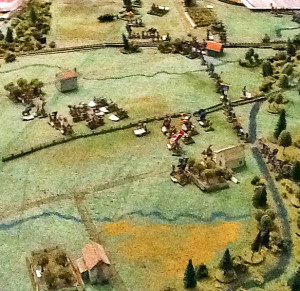
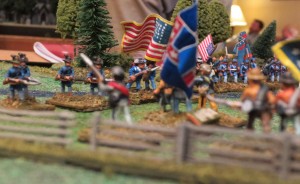
One response to “Playtest and After Action Report of “Across a Deadly Field””
Enjoyed this game review very much thank you